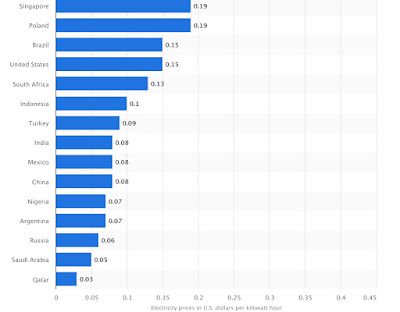The energy price surge: boon or woe
Electricity is one of the basic necessities of any household and a harbinger of growth for any country that seeks to achieve stability and prosperity in the post-industrialization age. According to United Nations, 13% of global population still lacks access to modern electricity. The Sustainable Development Goal (SDG-7): access to affordable, reliable, sustainable and modern energy still has not reached full adoption in many developing countries.
South Asia, particularly, Pakistan has seen a surge in energy prices for consumers. While, there are macroeconomic reasons to justify the surge, however, there are huge inefficiencies within the institutions, which if attended to, could mitigate the spillover costs to end consumers.
A comparison of electricity prices across the world shows that countries in South Asia are now seeking to shift towards alternate sources of energy, however, that has not resulted in maximizing the benefits to the masses that have to bear the costs of inefficient legacy power generating units leaving the energy infrastructure from generation to transmission in abysmal conditions.
Energy prices, particularly, gas tariff has risen over the years. In Bangladesh, industrial tariff is $3.66 per MMBtu as compared to $4.01 in the US, while Pakistan’s industrial gas tariff is at $7 per MMBtu, as of 2019, with a gradual decrease in gas resources in South Asia. In Pakistan, electricity tariff is double than India and other South Asian countries. While other countries in Asia including China, Indonesia, Malaysia and Vietnam have lower domestic tariff than industrial tariff that in turn minimizes the economic burden on households. Globally and in Middle East, Qatar has the lowest cost of electricity to households at $0.03 per kilowatt per hour due to its crude oil and natural gas production output and also being a net exporter of energy.
According to UNDP:
“Investing in solar, wind and thermal power, improving energy productivity, and ensuring energy for all is vital if we are to achieve SDG 7 by 2030.”
According to World Bank, Tracking SDG 7: The Energy Progress Report for 2020:
“Accelerating the pace of progress in all regions will require stronger political commitment, long-term energy planning, increased public and private financing, and adequate policy and fiscal incentives to spur faster deployment of new technologies.”
A few recommendations from Polyown Think Tank include:
In terms of affordability, reliability and sustainability of electricity supply, well-implemented and integrated power grid within South Asia can deliver multiple benefits. It can lead to a low carbon future of electricity that can transfer electricity for public good.
Countries like Pakistan and India have large reserves of coal also have significant potential for wind and solar power. Pakistan is undertaking a significant expansion of its generation fleet by adding coal, hydropower, solar and wind generation as part of the China-Pakistan Economic Corridor development under China’s Belt and Road Initiative. Cross border energy trade has the potential can lower costs of power and play a part in increasing access and affordability.
Availability of power can potentially trigger enhanced industrial activity, the income for such activities – coupled with additional revenue generated by electricity exports – opens up possibilities for increased investment in social or physical infrastructure and can help achieve affordability for consumers at the bottom of the pyramid.
Do you agree with our recommendations? Leave us your comments.
We at Polyown Think Tank value your opinion.





Comments
Post a Comment